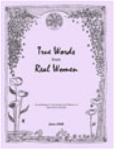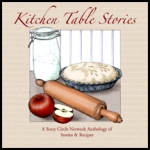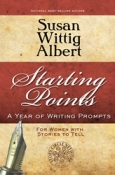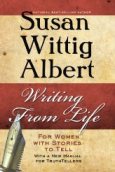Matilda Butler, ABC’s of Writing, #15
Earth Day 2011
It’s Earth Day and we’re celebrating in an unusual way. If you read our post on Women’s Memoirs, you’ll see that we pose some ideas for honoring the earth through individual actions and at the end of the post I even give you one of the small ways that I try to be careful with resources.
More importantly, we thought it would be appropriate to celebrate Earth Day 2011 by honoring four women who are nature writers — women who through their writing show us the world they see. Writing about a sense of place is one important element in our writing. These women write about place with skill and passion. The first two — Emily Dickinson and Annie Dillard — are featured in my Women’s Memoirs post today. These women help us note the beauty and the details of nature. They cause our eyes to linger longer on the sights we behold and to see nature in new and unexpected ways.
The other two women that I want to honor — Rachel Carson and Dian Fossey — took their nature writing toward activism. They wanted us to understand and see what they saw. But they also wanted us to take action to protect and save the earth from additional harm.
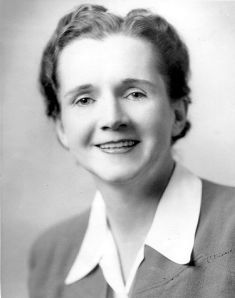 Rachel Carson (1907-1964), a marine biologist, was always considered an outsider in scientific circles. She was a woman in a man’s occupation. After her book Silent Spring was published, the chemical industry spoke out against her. It is reported that Ezra Taft Benson (former Secretary of Agriculture) wrote to Dwight D. Eisenhower that Carson was “probably a Communist” because she was unmarried despite being physically attractive. In other words, the “insiders” didn’t like this outsider who spoke directly to the American public about concerns for the earth and its potential impact on humans — especially when it had a negative impact on American industries. Carson is credited with the birth of the modern environmental movement.
Rachel Carson (1907-1964), a marine biologist, was always considered an outsider in scientific circles. She was a woman in a man’s occupation. After her book Silent Spring was published, the chemical industry spoke out against her. It is reported that Ezra Taft Benson (former Secretary of Agriculture) wrote to Dwight D. Eisenhower that Carson was “probably a Communist” because she was unmarried despite being physically attractive. In other words, the “insiders” didn’t like this outsider who spoke directly to the American public about concerns for the earth and its potential impact on humans — especially when it had a negative impact on American industries. Carson is credited with the birth of the modern environmental movement.
Interestingly, Carson did not urge a total ban on DDT but rather advised that it be used as cautiously as possible not only because of its negative effect on animals but because overuse would lead to DDT resistance.
Unfortunately, Carson’s life was cut short when she died of cancer in 1964, less than two years after the publication of Silent Spring.
I’d like to begin this celebration of Rachel Carson with a brief quote from her first book, The Sea Around Us.
In her own words:
“That primeval ocean, growing in bulk as the rains slowly filled its basins, must have been only faintly salt. But the falling rains were the symbol of the dissolution of the continents. From the moment the rain began to fall, the lands began to be worn away and carried to the sea. It is an endless, inexorable process that has never stopped–the dissolving of the rocks, the leaching out of their contained minerals, the carrying of the rock fragments and dissolved minerals to the ocean. And over the eons of time, the sea has grown ever more bitter with the salt of the continents.” p. 7. The Sea Around Us
Examine this passage from Carlson’s Silent Spring:
“One of the most tragic examples of our unthinking bludgeoning of the landscape is to be seen in the sagebrush lands of the West, where a vast campaign is on to destroy the sage and to substitute grasslands. If ever an enterprise needed to be illuminated with a sense of the history and meaning of the landscape, this is it. For here the natural landscape is eloquent of the interplay of forces that have created it. It is spread before us like the pages of an open book in which we can read why the land is what it is, and why we should preserve its integrity. But the pages lie unread.
“The land of the sage is the land of the high western plains and the lower slopes of the mountains that rise above them, a land born of the great uplift of the Rocky Mountain system many millions of years ago. It is a place of harsh extremes of climate: of long winters when blizzards drive down from the mountains and snow lies deep on the plains, of summers whose heat is relieved by only scanty rains, with drought biting deep into the soil, and drying winds stealing moisture from leaf and stem.
“As the landscape evolved, there must have been a long period of trial and error in which plants attempted the colonization of this high and windswept land. One after another must have failed. At last one group of plans evolved which combined all the qualifies needed to survive. The sage — low-growing and shrubby — could hold its place on the mountain slopes and on the plains, and within its small gray leaves it could hold moisture enough to defy the thieving winds. It was no accident, but rather the result of long ages of experimentation by nature, that the great plains of the West became the land of the sage.” pp pages 64-65 Silent Spring
 The second woman I want to honor is Dian Fossey (1932 – 1985) Dian’s life is probably well known to you for if you haven’t read her book, Gorillas in the Mist, you have probably seen the movie. So you already know that she was murdered for her passion to protect the mountain gorillas. Her observations of these creatures bring them to life for us.
The second woman I want to honor is Dian Fossey (1932 – 1985) Dian’s life is probably well known to you for if you haven’t read her book, Gorillas in the Mist, you have probably seen the movie. So you already know that she was murdered for her passion to protect the mountain gorillas. Her observations of these creatures bring them to life for us.
In her own words:
“Upon seeing me, all the animals instantly hid, with the exception of a young juvenile who treed to chestbeat and flamboyantly swing through the branches before leaping with a crash into the foliage below. Instantly I named him Icarus. The other group members, fifteen in all as I was later to learn, retreated about twenty feet father from where they had been feeding and peeked at me shyly through dense vegetation. However, the imp, Icarus, boldly climbed a tree again either to show off his acrobatic ability or to stare curiously at the first human being he had ever seen munching wild celery stalks.” p. 60 Gorillas in the Mist
As writers, we can use the models of Dickinson, Dillard, Carson, and Fossey to better understand writing about place. They are my role models in many ways and I hope they also inspire you.

